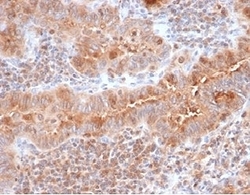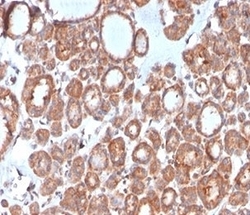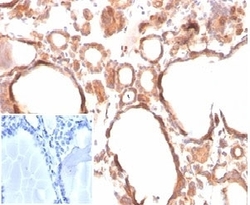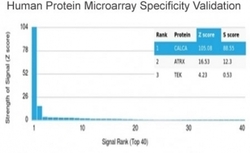Antibody data
- Antibody Data
- Antigen structure
- References [0]
- Comments [0]
- Validations
- Immunohistochemistry [3]
- Protein array [1]
Submit
Validation data
Reference
Comment
Report error
- Product number
- V9637 - Provider product page

- Provider
- NSJ Bioreagents
- Product name
- Calcitonin Antibody / CALCA / CGRP
- Antibody type
- Monoclonal
- Description
- Purified
- Reactivity
- Human
- Host
- Mouse
- Antibody clone number
- CALCA/3310
- Vial size
- 20 µg, 100 µg (with BSA, sodium azide), 100 µg (without BSA, sodium azide)
- Concentration
- 0.2 mg/ml, 1 mg/ml
- Storage
- Aliquot the Calcitonin antibody and store frozen at -20oC or colder. Avoid repeated freeze-thaw cycles.
No comments: Submit comment
Supportive validation
- Submitted by
- NSJ Bioreagents (provider)
- Main image

- Experimental details
- IHC staining of FFPE human thyroid with Calcitonin antibody (clone CALCA/3310). HIER: boil tissue sections in pH 9 10mM Tris with 1mM EDTA for 20 min and allow to cool before testing.
- Submitted by
- NSJ Bioreagents (provider)
- Main image

- Experimental details
- IHC staining of FFPE human thyroid tissue with Calcitonin antibody (clone CALCA/3310). HIER: boil tissue sections in pH 9 10mM Tris with 1mM EDTA for 20 min and allow to cool before testing.
- Submitted by
- NSJ Bioreagents (provider)
- Main image

- Experimental details
- IHC staining of FFPE human thyroid tissue with Calcitonin antibody (clone CALCA/3310). Negative control insert: PBS used in place of primary antibody. HIER: boil tissue sections in pH 9 10mM Tris with 1mM EDTA for 20 min and allow to cool before testing.
Supportive validation
- Submitted by
- NSJ Bioreagents (provider)
- Main image

- Experimental details
- Analysis of HuProt(TM) microarray containing more than 19,000 full-length human proteins using Calcitonin antibody (clone CALCA/3310). These results demonstrate the foremost specificity of the CALCA/3310 mAb. Z- and S- score: The Z-score represents the strength of a signal that an antibody (in combination with a fluorescently-tagged anti-IgG secondary Ab) produces when binding to a particular protein on the HuProt(TM) array. Z-scores are described in units of standard deviations (SD's) above the mean value of all signals generated on that array. If the targets on the HuProt(TM) are arranged in descending order of the Z-score, the S-score is the difference (also in units of SD's) between the Z-scores. The S-score therefore represents the relative target specificity of an Ab to its intended target.
 Explore
Explore Validate
Validate Learn
Learn Immunohistochemistry
Immunohistochemistry